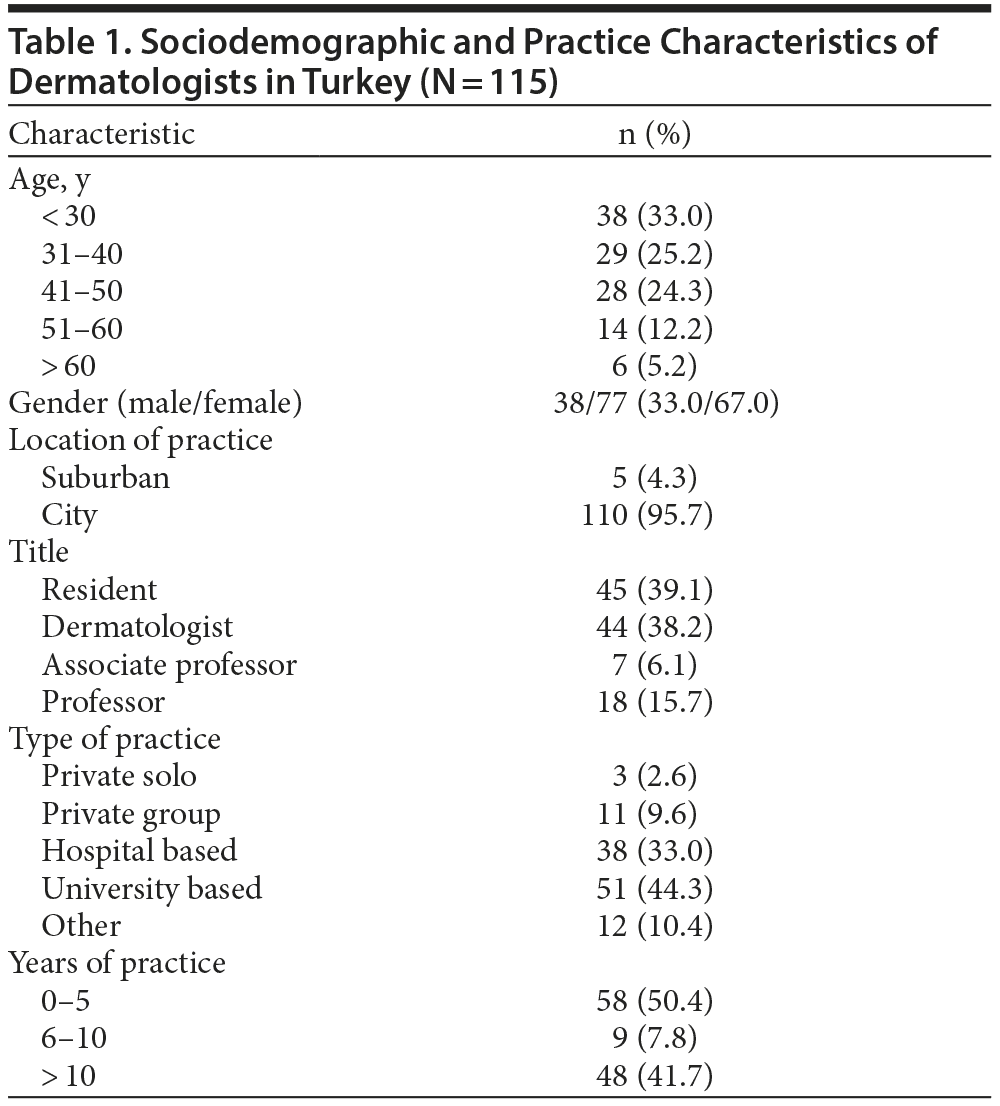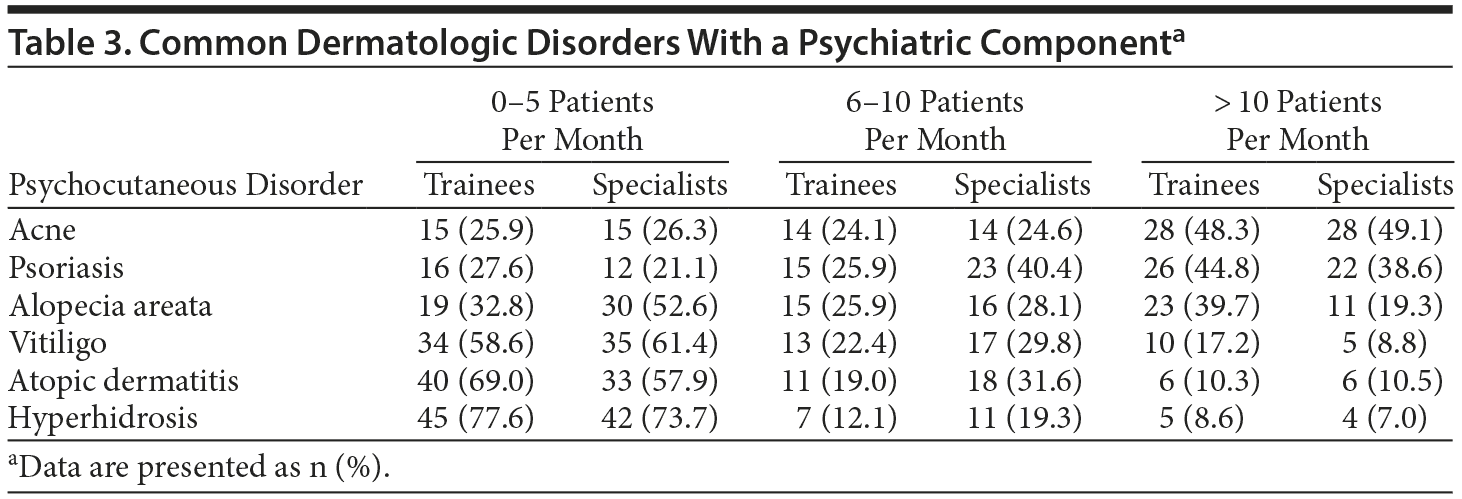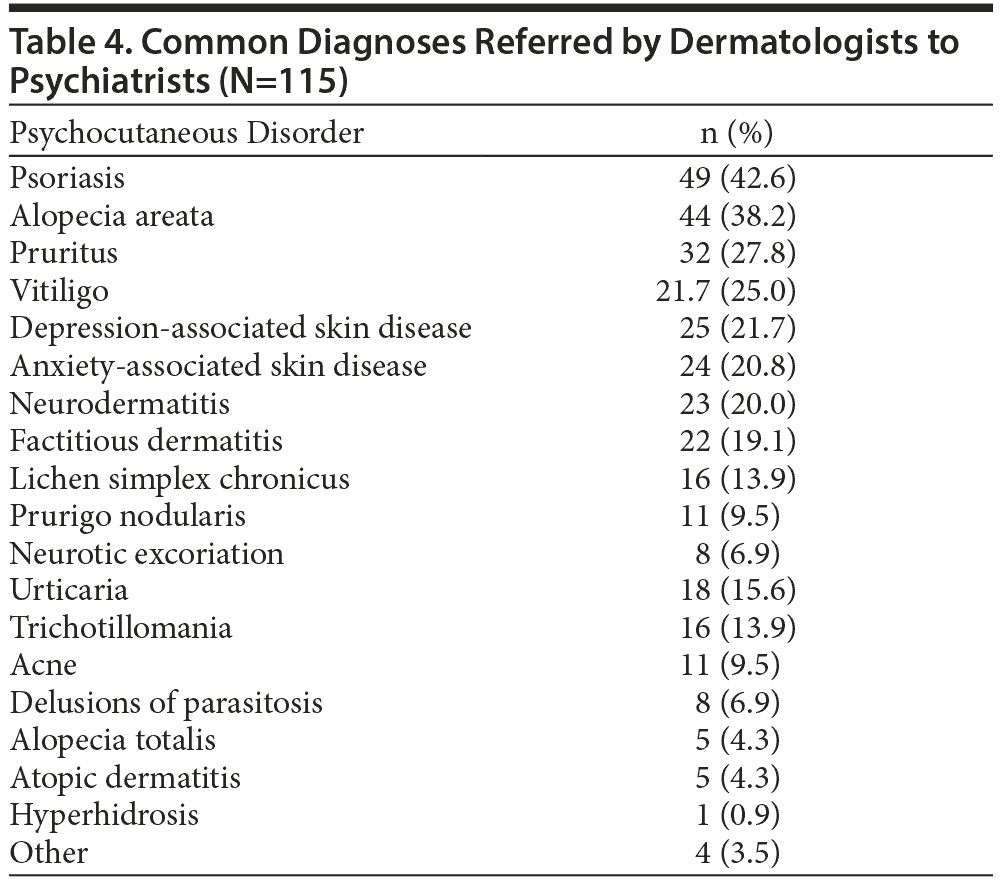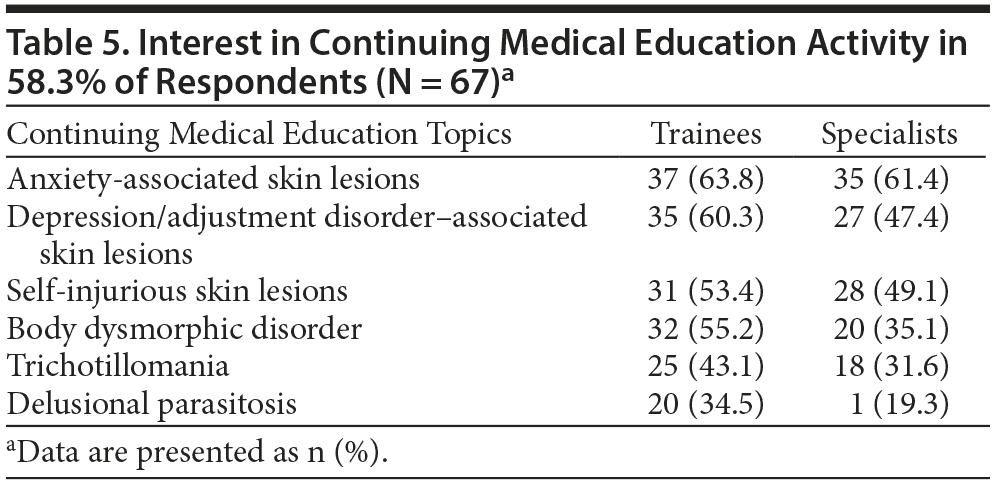Objective: Approximately, 1 in 3 patients in dermatology settings has psychiatric comorbidity. Thus, we conducted a survey in Turkey to explore the awareness, knowledge, practicing patterns, and attitudes of dermatologists toward psychocutaneous disorders.
Method: The questionnaire-based study was performed from March 1, 2013, to May 20, 2013. Study participants included 115 dermatologists. The questionnaire consisted of 9 multiple-choice questions and 2 open-ended questions.
Results: Of the 115 dermatologists in the study, 38 were men and 77 were women. More than 85% of dermatologists indicated that they examine > 30 patients per week in their practice, while only 2% saw < 10 patients per week. The most frequent dermatologic condition associated with psychiatric involvement seen by dermatologists was acne (49.1%). The top 3 diagnoses referred by dermatologists to psychiatrists were psoriasis (42.6%), alopecia areata (38.2%), and pruritus (27.8%).
Conclusions: A need for collaboration between primary care, psychiatry, and dermatology disciplines in handling patients with psychocutaneous conditions is widely accepted. Investigating the knowledge, attitudes, and awareness of dermatologists about psychocutaneous disorders might contribute to the development of new educational strategies and elicit qualified biopsychosocial approaches.
Psychodermatology: Knowledge, Awareness, Practicing Patterns, and Attitudes of Dermatologists in Turkey

ABSTRACT
Objective: Approximately, 1 in 3 patients in dermatology settings has psychiatric comorbidity. Thus, we conducted a survey in Turkey to explore the awareness, knowledge, practicing patterns, and attitudes of dermatologists toward psychocutaneous disorders.
Method: The questionnaire-based study was performed from March 1, 2013, to May 20, 2013. Study participants included 115 dermatologists. The questionnaire consisted of 9 multiple-choice questions and 2 open-ended questions.
Results: Of the 115 dermatologists in the study, 38 were men and 77 were women. More than 85% of dermatologists indicated that they examine > 30 patients per week in their practice, while only 2% saw < 10 patients per week. The most frequent dermatologic condition associated with psychiatric involvement seen by dermatologists was acne (49.1%). The top 3 diagnoses referred by dermatologists to psychiatrists were psoriasis (42.6%), alopecia areata (38.2%), and pruritus (27.8%).
Conclusions: A need for collaboration between primary care, psychiatry, and dermatology disciplines in handling patients with psychocutaneous conditions is widely accepted. Investigating the knowledge, attitudes, and awareness of dermatologists about psychocutaneous disorders might contribute to the development of new educational strategies and elicit qualified biopsychosocial approaches.
Prim Care Companion CNS Disord 2015;17(2):doi:10.4088/PCC.14m01628
© Copyright 2015 Physicians Postgraduate Press, Inc.
Submitted: January 19, 2014; accepted October 28, 2014.
Published online: April 30, 2015.
Corresponding author: Mohammad Jafferany, MD, Psychodermatology Clinic, Jafferany Psychiatric Services, 3215 Hallmark Court, Saginaw, MI 48603 ([email protected]).
Psychocutaneous diseases can be defined as diseases that are elicited or triggered by emotional states1 or stress.2,3 Hence, psychodermatology seems to be a subspecialty dealing with the patients in the psychiatric and dermatologic interdisciplinary domain.4 The prevalence of psychiatric comorbidity in the outpatient settings was reported to be as high as 25%-30%,5 and inpatients in dermatology wards were found to have higher psychiatric comorbidity than general medical inpatients.4 In their routine practice, both dermatologists and psychiatrists see a considerable amount of patients with psychocutaneous disease. The patients with dermatologic problems often resist psychiatry referral5; thus, the dermatologists provide a bulk of psychodermatologic care. In a previous study, only 18% of dermatologists reported to have an understanding of psychodermatology, while 42% of them had no training in psychodermatology.4 Many specialists from both disciplines (ie, psychiatry and dermatology) feel underprepared and seem to have less interest/comfort in treating patients with psychocutaneous disorders compared to patients with pure psychiatric or dermatologic symptoms,6 which leaves many patients with psychocutaneous disorders undertreated.
Keeping in mind the importance of psychodermatology, we conducted a questionnaire-based study in Turkey to explore the awareness, knowledge, practicing patterns, and attitudes of dermatologists with regard to psychodermatologic disorders.
METHOD
The study was performed from March 1, 2013, to May 20, 2013. We contacted 120 dermatologists in a national congress of dermatology in Istanbul, and 27 refused to fill out the questionnaire. In addition, we asked 30 dermatologists who live in Istanbul to participate in the study, and 8 did not agree to participate. Thus, the participants consisted of 115 dermatologists. After providing oral informed consent to enroll in the study, all participants were asked to fill out a questionnaire anonymously. The research was performed in accordance with the Declaration of Helsinki criteria.
Questionnaire
The questionnaire was obtained from M.J., who was researching the attitudes of dermatologists and psychiatrists regarding psychocutaneous disorders.4,7 The questionnaire consisted of 9 multiple-choice questions and 2 open-ended questions, which were adapted to Turkish by the authors (T.O., A.S.K., and A.B). The first question (open ended) asked participants about the meaning of psychodermatology, while questions 2 through 5 asked about the frequency of patients with psychocutaneous disorder in their daily practice. One question asked about the feelings of dermatologists when confronted with such patients. Two questions asked about the dermatologists’ attitudes with regard to referral of patients to psychiatrists. The final 3 questions asked about the dermatologists’ previous training in psychodermatology and willingness to receive future education, as well as knowledge of a source of information for patients and their relatives.
Statistical Analysis
Statistical analysis was performed with SPSS for Windows version 15.0 (SPSS Inc, Chicago, Illinois). The frequency of data was calculated and categorical data were analyzed using the χ2 test. A P value < .05 was accepted as statistically significant.
RESULTS
The study included 115 dermatologists, of whom 38 were men and 77 were women. The number of resident trainees was 45, while the number of specialists was 70 (1 had missing data). Of the participants, 103 were born in Turkey, and 11 were born outside of Turkey (1 had missing data). The demographic and practice characteristics of participants are shown in Table 1.
The response of participants to "What is your understanding about what psychodermatology is?" was as follows: (1) it is the dermatologic manifestations of psychiatric disorders (29.31% of trainees, 52.63% of specialists), (2) symptoms of bidirectional interaction between psychiatric and dermatologic illnesses (32.75% of trainees, 33.33% of specialists), (3) no comment (24.13% of trainees, 10.52% of specialists), and (4) dermatologic diseases that cause psychiatric disorders (13.79% of trainees, 3.5% of specialists).
In this study, 86.6% of trainees (n = 39) and 77.3% (n = 58) of specialists mentioned that "they examine > 30 patients per week" in their practice. There was no statistically important difference.
Eight in 10 dermatologists reported that "they have frequent or some experiences with psychodermatology" (77.7% [n = 35] of trainees and 87.1% [n = 61] of specialists). Approximately 70% of both trainees and specialists endorsed that "in their daily practice in dermatology outpatient clinics, 10%-50% of patients may have psychiatric components." Strikingly, only 2 trainees and 7 specialists felt very comfortable when treating patients with psychodermatologic conditions. Nearly 1 in 4 trainees and specialists felt somewhat comfortable, while 1 in 5 trainees and 1 in 8 specialists felt somewhat uncomfortable. There was no statistically significant difference between trainees and specialists in feeling comfortable while treating patients with psychocutaneous disorders. The practice patterns and feelings of dermatologists in treating patients with skin disorders with psychological component are summarized in Table 2.

- Psychodermatology is an emerging subspecialty.
- Collaboration among primary care physicians, dermatologists, and mental health professionals is vital for the diagnosis and management of psychocutaneous disorders.
- More education and curricular changes with regard to psychodermatology are required in training programs.
The 3 most common dermatologic conditions associated with psychiatric involvement seen by trainees and specialists were acne, psoriasis, and alopecia areata (number and frequency of patients examined per month reported respectively for trainees and specialists in Table 3).
Of dermatologists, 73.9% reported that "they refer patients with psychocutaneous disorder to a psychiatrist" ≥ 1 time per month. There was no statistically significant difference between trainees and specialists. The top 5 diagnoses referred by dermatologists to psychiatrists were psoriasis (42.6%, n = 49), alopecia areata (38.2%, n = 44), pruritus (27.8%, n = 32), vitiligo (21.7%, n = 25), and depression associated with skin disease (21.7%, n = 25) (Table 4).
When asked about participation in psychodermatology education during their training, 66.6% of trainees and 42.8% of specialists responded "never," while 17.7% of trainees and 38.5% of specialists answered "more than one." The specialists participated in education more than trainees, and this difference was statistically significant (P = .009).
Strikingly, 95.5% of trainees and 94.2% of specialists were not aware of any patient or parent source for psychodermatology. When dermatologists were asked whether they want to attend any continuing medical education (CME) event on psychodermatology, 60% of trainees and 57.1% of specialists responded "willing" and 8.8% of trainees and 7.14% of specialists were "unwilling," while 31.1% of trainees and 35.7% of specialists reported "maybe." The difference between trainees and specialists was not statistically significant. The 3 most frequent topics among dermatologists who were in favor of psychodermatology CME courses were as follows: anxiety-associated skin lesions (63.8% of trainees, 61.4% of specialists), depression-associated skin lesions (60.3% of trainees, 47.4% of specialists), and self-injurious skin lesions (53.4% of trainees, 49.1% of specialists) (Table 5).
The χ2 test comparing the interest of dermatologists in participating in psychodermatology CME activities by age groupings of practitioners, as well as by length, type, and location of practice, feeling comfortable treating patients with psychocutaneous disorders, and referral to a psychiatrist, showed that there were no remarkable or statistically significant differences in interest among subgroups of practitioners. However, dermatologists practicing > 10 years refer patients with psychocutaneous disorders to a psychiatrist 1 or more times per week, while dermatologists practicing < 5 years refer patients 1 or more times per month, which was a statistically significant finding (χ2 = 19.447 and P = .003).
DISCUSSION
To our knowledge, we are the first in Turkey to investigate the knowledge, awareness, practice patterns, and training needs of dermatologists regarding psychodermatologic disorders. In this study, 8 in 10 dermatologists reported that they have frequent or some experiences with psychodermatology. In a recently published study from Chile,8 75% of dermatologists indicated that they frequently see patients with psychodermatologic problems in their clinical practice. Approximately 70% of both trainees and specialists indicated that "in their daily practice in dermatology outpatient clinics, 10-50% of patients may have psychiatric components." In previous studies, the comorbidity of psychiatric conditions in outpatient dermatology clinics was found to be 25%-30%.1,9 The discordance and wide range of our findings among dermatologists for psychiatric conditions might be due to the subjectivity of our study design. Strikingly, only 9 dermatologists felt very comfortable and nearly 1 in 4 trainees and specialists felt somewhat comfortable in treating patients with psychodermatologic conditions, while 1 in 5 trainees and 1 in 8 specialists felt somewhat uncomfortable. According to Elpern,6 most dermatologists may be uneasy when treating patients with psychodermatologic conditions because of inadequate training and less interest and, therefore, may be more likely to use more well-known dermatologic treatments. In the study by Mu×±oz et al,8 41% of dermatologists mentioned that they feel comfortable while treating patients who have dermatologic conditions. However, in a study of US dermatologists by Jafferany et al,4 the ratio of feeling very or somewhat comfortable in treating patients with psychodermatologic conditions was 83.4%, which is approximately 3-fold greater than that of dermatologists from Turkey. While Jafferany et al4 excluded dermatology residents from their study, 39.1% of the dermatologists in the current study were residents; however, there was no statistically significant difference between trainees and specialists in feeling comfortable while treating patients with psychocutaneous disorders. Maybe the awareness of dermatologists about psychodermatologic conditions might be higher in Western countries than in Turkey. Thus, the ratio of attending psychodermatology educational training was higher in the study by Jafferany et al4 than in our participants. In the current study, the participation of specialists in CME was higher compared to trainees, but the education did not seem to make enough of an impact with regard to feeling comfortable when treating these patients.
In the current study, acne was the most-mentioned dermatologic disease with psychiatric presentation, followed by psoriasis and alopecia areata. In a recently published study in India,10 patients with acne vulgaris (n = 106) were classified as having mild acne (25.2%), moderate acne (50.5%), or severe acne (24.3%) and were compared to age- and gender-matched healthy controls. Of the acne vulgaris patients, 34% of had high psychoticism scores and 31.1% had high depressive scores according to the Symptom Check List.10 Stress has been noted in the onset or exacerbation of psoriasis.11 Furthermore, in a comprehensive review, depression and suicidal ideation were mostly reported in psoriasis than in other psychocutaneous diseases such as acne vulgaris, atopic dermatitis, and alopecia areata.9 In addition, depressive and anxiety feelings and hypochondriac tendencies were more frequently reported in alopecia areata than in healthy controls.12 Thus, misrecognition of psychiatric comorbidities in dermatologic diseases might worsen psychiatric symptoms, disturb quality of life, and result in suicide attempts13 and also might lead to inefficient treatment of dermatologic disease and either exacerbations or treatment inadherence due to psychiatric symptoms.
Referral of psychocutaneous disorders to psychiatrists by dermatologists seems critical. In our study, psoriasis, alopecia areata, pruritus, vitiligo, depression, and anxiety associated with skin diseases were the 6 most commonly reported referrals to psychiatry by dermatologists. However, delusion of parasitosis, neurotic excoriation, and trichotillomania were found to be the most common referrals by dermatologists in a US study.4 Strikingly, only 8 of the dermatologists in our study emphasized that they refer delusion of parasitosis. Patients with delusional parasitosis are usually seen first by psychiatrists then by dermatologists,14 which might support our findings. In our study, we considered that dermatologists might be more alert to psychiatric comorbidity associated with psoriasis and alopecia areata, which might be exacerbated or initiated by stressors.11 Interestingly, if we cluster factitious dermatitis, lichen simplex chronicus, prurigo nodularis, and neurotic excoriation within the neurodermatitis category in our study, this psychocutaneous disorder becomes the most common reason of referral to psychiatrists by dermatologists. Psychopathologically, patients with neurodermatitis might have personality traits such as compulsive or perfectionism of which the extent and degree of self-excoriation has been reported to be a reflection of underlying personality or other concomitant psychiatric disorders.13 Thus, dermatologists might need further help by psychiatrists in the management of neurodermatitis.
In a Chilean study,8 50% of the dermatologists expressed that they would be interested in CME in psychodermatology. In our survey, 58.3% of dermatologists mentioned interest in attending CME courses about psychodermatology, while 33.9% said "maybe" and 7.8% expressed "no interest" in such courses. The interest among dermatologists in Turkey seems to be 1.5-fold more than among dermatologists in America,4 although 52.2% of dermatologists in our survey have never attended a course about psychodermatology. Interestingly, 95.6% of dermatologists in the current survey were unaware of any available resource on psychodermatology in Turkey. Thus, the relatively low interest and lack of knowledge with regard to psychocutaneous disorders among dermatologists in Turkey should be targeted areas of improvement. In the present study, more than 1 in 2 dermatologists who were interested in attending CME events indicated that they wanted to learn about anxiety, depression, and adjustment disorders associated with skin lesions and self-injurious skin lesions. Undoubtedly, patients with dermatologic problems who have above-mentioned comorbid states might need a great deal of psychotherapeutic and/or psychopharmacologic approaches.
This study has several limitations. First, dermatologists with an interest in CME events might have been more likely to respond to our survey because most of them were attendees of the dermatology congress. Second, the self-report design of the study might have led to some bias. Third, the relatively small sample size does not allow our findings to be generalized to the whole country.
In conclusion, need for collaboration between primary care, psychiatry, and dermatology disciplines in handling patients with psychocutaneous conditions has already been accepted in the literature.15,16 This survey is the first to explore the knowledge, attitudes, and daily practices of dermatologists in Turkey with regard to psychocutaneous disorders. Although more dermatologists see dermatologic patients who have psychiatric problems, they (both trainees and specialists) usually do not feel as comfortable as their colleagues in other parts of the world when managing such patients. Increasing the knowledge of primary care physicians about psychocutaneous disorders might lead to more accurate recognition of comorbid psychiatric issues and well-timed support by psychiatrists, leading to increased comfort among primary care physicians and dermatologists, and the patients would be appropriately treated through this multidisciplinary approach. However, in Turkey, the lack of formal training in psychiatric issues and relatively few CME activities on psychocutaneous disorders in primary care and dermatology education and practice seem to be important areas in need of improvement.
Author affiliations: Department of Psychiatry, Medical School of Cerrahpasa, Istanbul University, Istanbul, Turkey (Drs Ocek, Kani, BaÅŸ, Turan, and Emul); Erenkoy Mental Health and Neurology Training and Research Hospital, Istanbul, Turkey (Dr Yalcin); and Psychodermatology Clinic, Jafferany Psychiatric Services and Department of Psychiatry and Behavioral Sciences, Central Michigan University, Saginaw, Michigan (Dr Jafferany).
Potential conflicts of interest: None reported.
Funding/support: None reported.
REFERENCES
1. Fried RG, Hussain SH. Nonpharmacologic management of common skin and psychocutaneous disorders. Dermatol Ther. 2008;21(1):60-68. PubMed doi:10.1111/j.1529-8019.2008.00171.x
2. Shenefelt PD. Psychodermatological disorders: recognition and treatment. Int J Dermatol. 2011;50(11):1309-1322. PubMed doi:10.1111/j.1365-4632.2011.05096.x
3. Orion E, Wolf R. Psychological factors in skin diseases: stress and skin: facts and controversies. Clin Dermatol. 2013;31(6):707-711. PubMed doi:10.1016/j.clindermatol.2013.05.006
4. Jafferany M, Vander Stoep A, Dumitrescu A, et al. The knowledge, awareness, and practice patterns of dermatologists toward psychocutaneous disorders: results of a survey study. Int J Dermatol. 2010;49(7):784-789. PubMed
5. Gee SN, Zakhary L, Keuthen N, et al. A survey assessment of the recognition and treatment of psychocutaneous disorders in the outpatient dermatology setting: how prepared are we? J Am Acad Dermatol. 2013;68(1):47-52. PubMed doi:10.1016/j.jaad.2012.04.007
6. Elpern DJ. Darkness visible: psychocutaneous disease. South Med J. 2010;103(12):1196. PubMed doi:10.1097/SMJ.0b013e3181fa740e
7. Jafferany M, Stoep AV, Dumitrescu A, et al. Psychocutaneous disorders: a survey study of psychiatrists’ awareness and treatment patterns. South Med J. 2010;103(12):1199-1203. PubMed doi:10.1097/SMJ.0b013e3181fa73ef
8. Mu×±oz LU, Calderón PH, Castro AL, et al. Psychocutaneous disease: knowledge and clinical attitudes of Chilean dermatologists. Int J Dermatol. 2014;53(4):e266-e267. PubMed
9. Picardi A, Lega I, Tarolla E. Suicide risk in skin disorders. Clin Dermatol. 2013;31(1):47-56. PubMed doi:10.1016/j.clindermatol.2011.11.006
10. Behnam B, Taheri R, Ghorbani R, et al. Psychological impairments in the patients with acne. Indian J Dermatol. 2013;58(1):26-29. PubMed doi:10.4103/0019-5154.105281
11. Al’ Abadie MS, Kent GG, Gawkrodger DJ. The relationship between stress and the onset and exacerbation of psoriasis and other skin conditions. Br J Dermatol. 1994;130(2):199-203. PubMed doi:10.1111/j.1365-2133.1994.tb02900.x
12. Alfani S, Antinone V, Mozzetta A, et al. Psychological status of patients with alopecia areata. Acta Derm Venereol. 2012;92(3):304-306. PubMed doi:10.2340/00015555-1239
13. Jafferany M. Psychodermatology: a guide to understanding common psychocutaneous disorders. Prim Care Companion J Clin Psychiatry. 2007;9(3):203-213. PubMed doi:10.4088/PCC.v09n0306
14. Lepping P, Freudenmann RW. Delusional parasitosis: a new pathway for diagnosis and treatment. Clin Exp Dermatol. 2008;33(2):113-117. PubMed doi:10.1111/j.1365-2230.2007.02635.x
15. Mercan S, Kivanç Altunay I. Psychodermatology: a collaboration between psychiatry and dermatology [article in Turkish]. Turk Psikiyatri Derg. 2006;17(4):305-313. PubMed
16. Chung WL, Ng SS, Koh MJ, et al. A review of patients managed at a combined psychodermatology clinic: a Singapore experience. Singapore Med J. 2012;53(12):789-793. PubMed
Please sign in or purchase this PDF for $40.00.
Save
Cite





